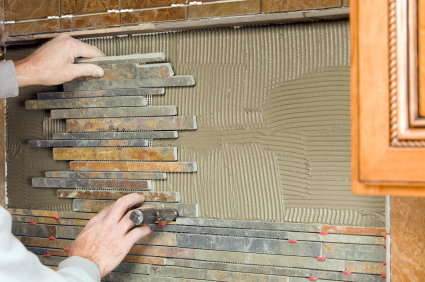A Comparison of Tile Backer Boards
 Earlier this month, I started with a shower tile renovation for one of my Denver tile contracting clients. In this particular case the shower tile was still intact, which is a rarity considering the tile was set on green board. I think the main reason it had survived was that it was relatively new, as this house was only built in 1996. Back in the old days, green board was widely used as a tile substrate. People would be making a big mistake to use it now. (It was banned from use for “wet areas” with the 2006 IRC building code.) What was more surprising was that cement-based backer boards were available when this home was built and this green board use reflects a cost-cutting measure that is usually a mistake.
Earlier this month, I started with a shower tile renovation for one of my Denver tile contracting clients. In this particular case the shower tile was still intact, which is a rarity considering the tile was set on green board. I think the main reason it had survived was that it was relatively new, as this house was only built in 1996. Back in the old days, green board was widely used as a tile substrate. People would be making a big mistake to use it now. (It was banned from use for “wet areas” with the 2006 IRC building code.) What was more surprising was that cement-based backer boards were available when this home was built and this green board use reflects a cost-cutting measure that is usually a mistake.
The right backer board for wet or dry areas
Tile can be set just about anywhere, most commonly on floors and walls. As a tile contractor, I have even installed some on ceilings. The main consideration for backer choice is the location of the tile. Backsplashes and some tile wainscot can be set on regular drywall (or fiberglass versions of drywall). Water and gypsum-based backers = mush in my book. It seems that building officials now agree. An added bonus to cement board use is its resistance to mold growth. That old green board was still paper-based and mold loves to eat paper.
Types of cement backer board
Permabase is National Gypsum’s product and it is very much like WonderBoard from Custom Building Products. Both of these boards are a cement and aggregate core with a fiberglass mesh “skin.” Durock from USG is a slightly lighter weight version of comparable construction methods.
HardieBacker – My favorite backer board
The other main type is what I call the “Hardie” type. HardieBacker is a non-aggregate based product from James Hardie, the same company that makes HardiePlank siding. Custom Building Products has their version of this, called Rhino board, but they limit it to ¼” thick and recommend it for floors and countertop installations.
Backer board by the numbers
Cost, strength, and weight will vary from product to product. In my area the cost of a 3 x 5 foot ½ inch thick sheet of any of these products runs about $11. The ¼” thick versions are usually about a dollar cheaper. Weights range from 2.4 pounds / sq ft to 3.0 pounds / sq ft for the ½” thick stock. That equates to 36 pounds for the lighter weight Durock and 45 pounds for the WonderBoard.
HardieBoard is in between at 2.6 pounds sq ft or 39 pounds for a 3 x 5 foot sheet. These numbers can mean a lot when you need to carry a dozen sheets up three flights of stairs (like a project I did a few months ago). Where the biggest differences lie, however, are in the strength department. The aggregate-based products are lower in both flexural strength at about 750 to 900 (psi) and in compressive strength at about 2200 to 2500 (psi). The “Hardie” type is more than double in both areas: 1700 psi flexural and 6500 psi compressive. To give you an idea of how tough that is, fiberglass-skinned “drywall” like DensShield is only 450-600 psi compressive.
What backer board I use and why
For normal shower installs, I prefer the HardieBoard hands down. The primary reason is the ease of cutting and lack of crumbly aggregate. HardieBoard’s “grain” is very fine and does not release the fine gravel-like particles the other aggregate type products do. You can score this for cuts, but I use a thin diamond dry cutting blade in my grinder. It makes more dust this way, but it is fast and leaves a very clean edge. (Breathing this dust is bad, so cut outdoors and use a dust mask.) The lack of aggregate in the “Hardie” types reduces the chance of gouging a new acrylic or shinny new enameled tub.
I have used all of these products over the years, and I chose WonderBoard for my cabin's floor primarily for its highest mass; in that project I was looking for thermal mass in a passive solar design. The WonderBoard there, in my 200 sq foot cabin, gave me about half of my estimated 1200 to 1400 pound thermal mass floor.
Kevin Stevens writes for Networx.com.
Updated December 11, 2017.
Looking for a Pro? Call us (866) 441-6648

Tile Contractors Experiences

Thoroughly Modern Bathroom Remodel

New Kitchen Floor Tile After Water Damage



